A team of teachers in our Learning by Design project describes one of the ways in which they create an inclusive learning environment. Three teachers describe approaches they have taken to classroom diversity.

Margaret, an experienced classroom teacher, explains how three boys with literacy problems became engaged in paper bridge building.
‘I put them together rather than with a more capable student so they had to rely on their own resources and each other. They worked well together and the more capable students worked well together taking the activity to another level. The boys showed greater cooperation and more planning than usual, and they wrote in their reflective journals to evaluate the bridges!’
‘This worked well,’ Margaret added, because they had to rely on each other while sometimes the more capable students don’t let them do anything. I found that with open-ended tasks, ability grouping was better whereas for closed tasks mixed ability grouping was better. With ability grouping there was greater commitment to the project and fewer behavioural problems. Everyone was involved.’
Therese discovered that pairing younger and older students produced interesting results.
‘The younger students were pushed to keep up with the older students to impress them while the older students were pushed to take on a leadership role in working with the younger students.’ The older students developed a greater sense of responsibility for completing tasks, and both younger and older students were motivated to produce quality work.
Melissa found that giving a child with Asperger’s Syndrome the freedom to choose to work on her own for this paired activity worked well.
‘She chose from a menu of ways to record her ideas in her reflection journal producing quality work.’
She gave another child with special needs responsibility for recording the class learning activities in the class big book version of the Learning Element [the Learning by Design documentation template].
‘He was engaged and enthusiastic rather than withdrawing and doing his own thing.’
Burrows, Peter, Bill Cope, Mary Kalantzis, Les Morgan, Kieju Suominen and Nicola Yelland. 2006. ‘Data from the Australian Research Council Learning By Design Project.’ Unpublished Manuscript.
